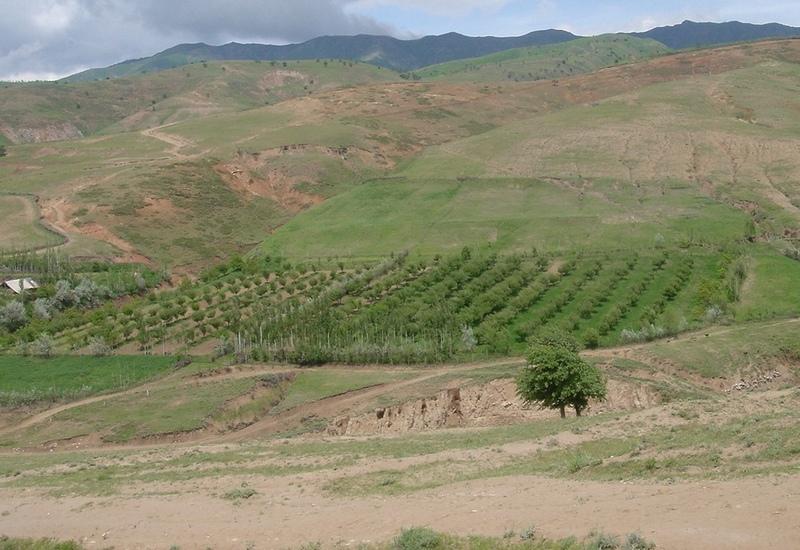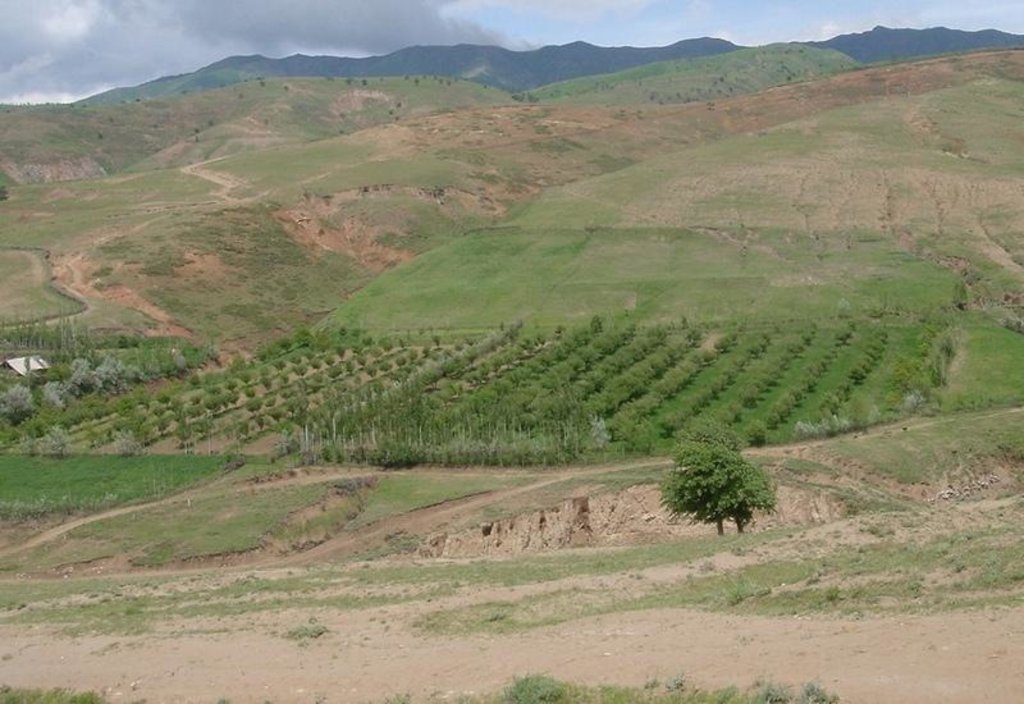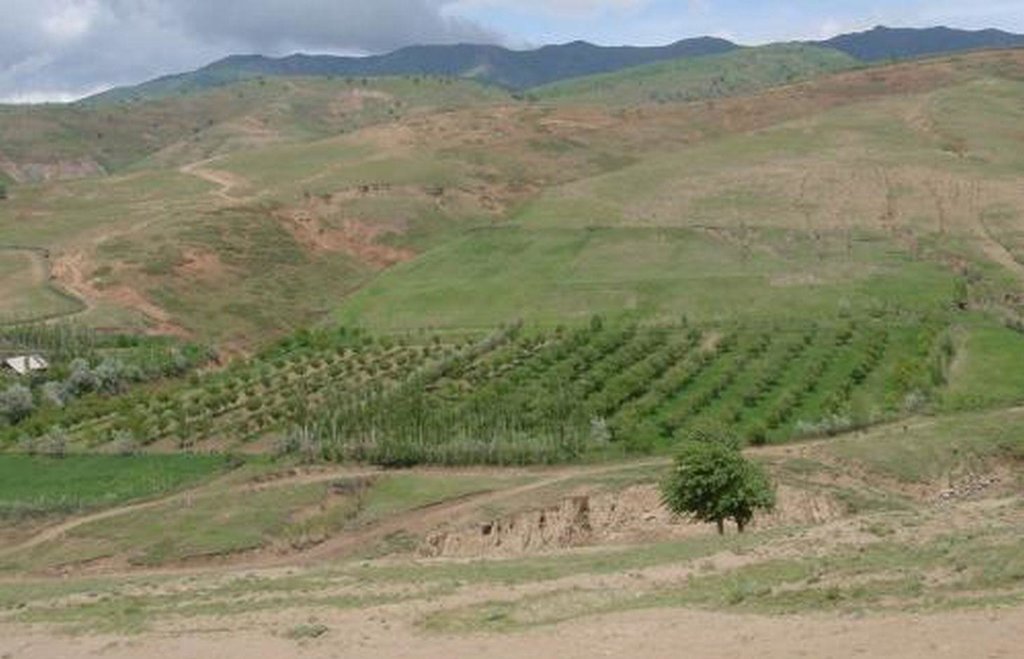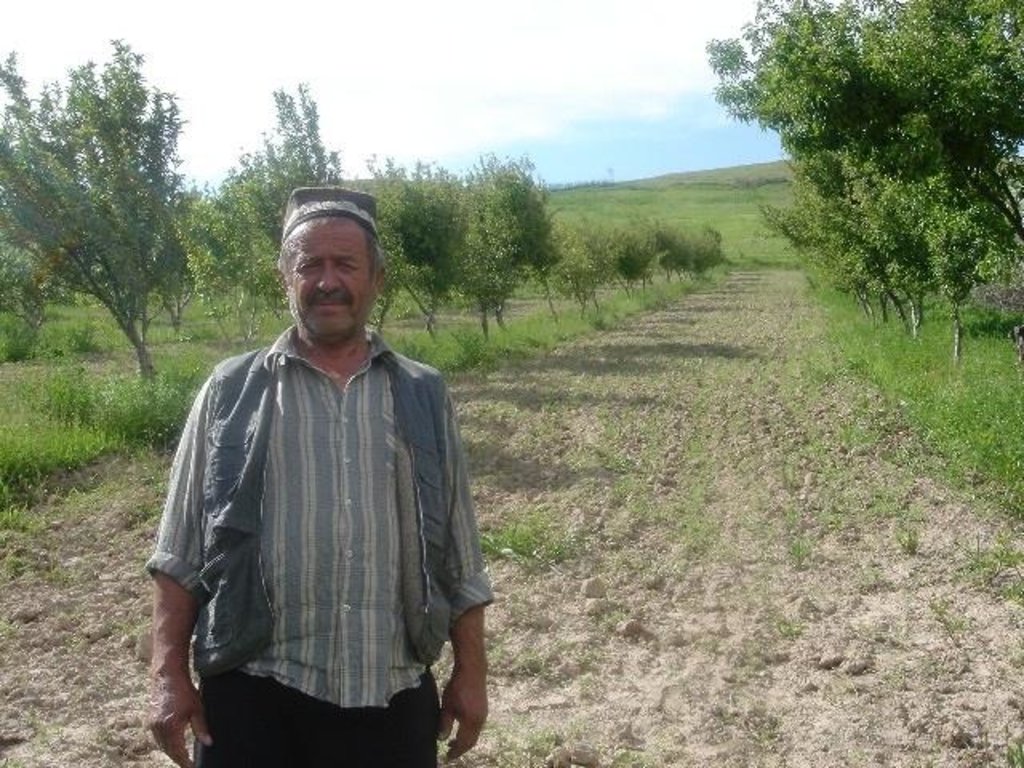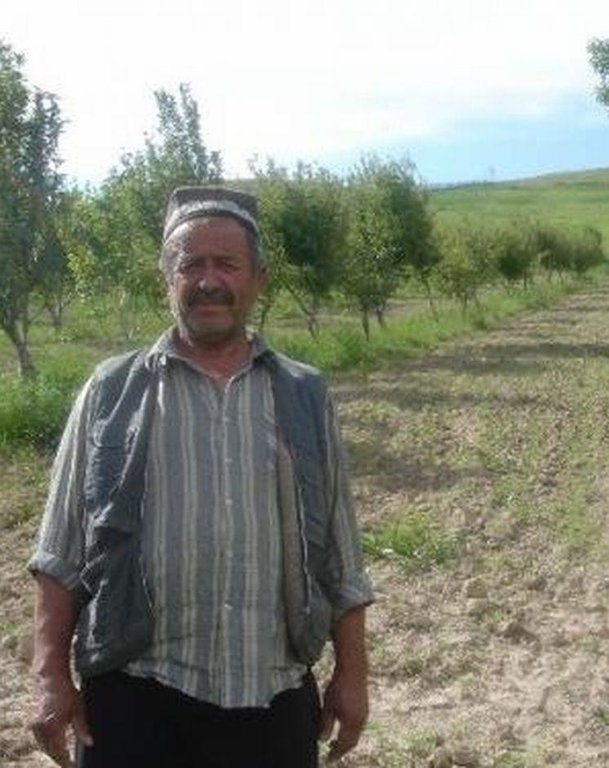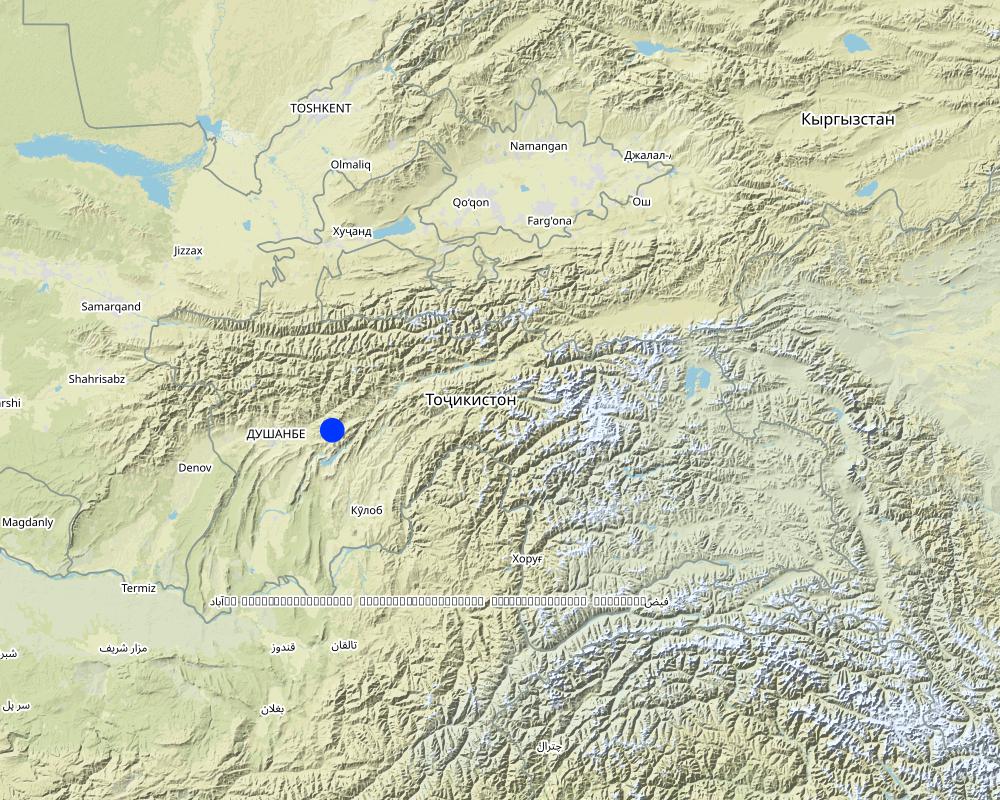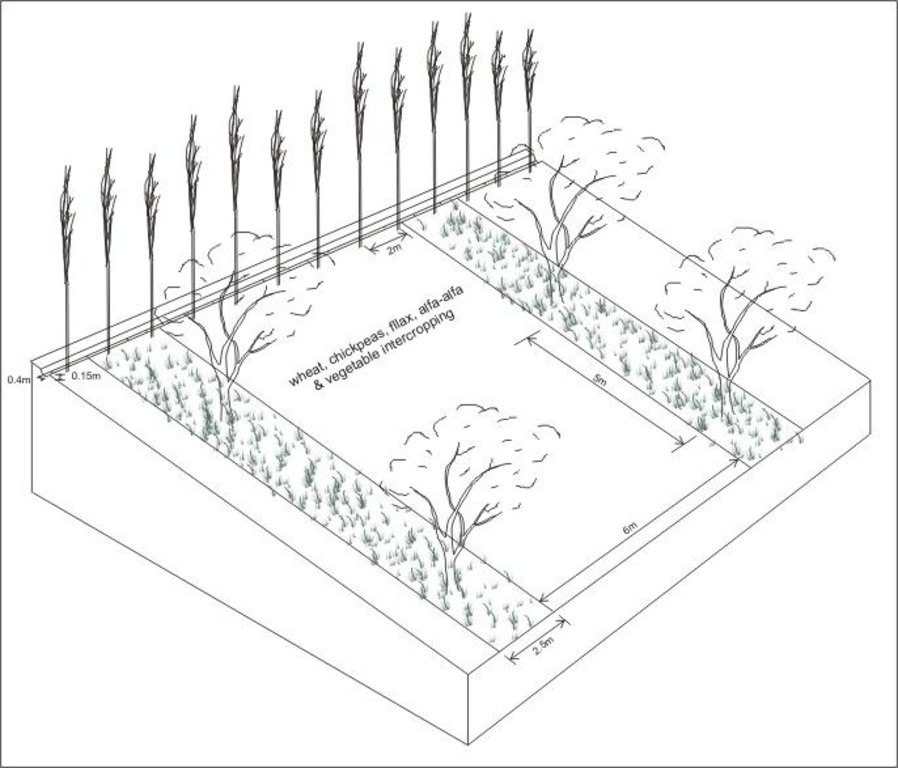Orchard-based Agroforestry (establishment of orchard) [塔吉克斯坦]
- 创建:
- 更新:
- 编制者: Erik Bühlmann
- 编辑者: –
- 审查者: David Streiff, Alexandra Gavilano, Joana Eichenberger
technologies_1001 - 塔吉克斯坦
- Orchard-based Agroforestry (establishment of orchard): Aug. 20, 2019 (inactive)
- Orchard-based Agroforestry (establishment of orchard): Nov. 2, 2021 (public)
- Orchard-based Agroforestry (establishment of orchard): July 19, 2017 (inactive)
- Orchard-based Agroforestry (establishment of orchard): July 17, 2017 (inactive)
- Orchard-based Agroforestry (establishment of orchard): March 10, 2017 (inactive)
查看章节
全部展开 全部收起1. 一般信息
1.2 参与该技术评估和文件编制的资源人员和机构的联系方式
SLM专业人员:
有助于对技术进行记录/评估的项目名称(如相关)
Pilot Program for Climate Resilience, Tajikistan (WB / PPCR)有助于对技术进行记录/评估的机构名称(如相关)
CDE Centre for Development and Environment (CDE Centre for Development and Environment) - 瑞士有助于对技术进行记录/评估的机构名称(如相关)
NCCR North-South (NCCR North-South) - 吉尔吉斯斯坦1.3 关于使用通过WOCAT记录的数据的条件
编制者和关键资源人员接受有关使用通过WOCAT记录数据的条件。:
是
1.5 参考关于SLM方法(使用WOCAT记录的SLM方法)的调查问卷

Voluntary Labour Assistance [塔吉克斯坦]
Voluntary labour assistance for labour intensive activities whereby community members help each other in contributing labour on the basis of mutual understanding.
- 编制者: Erik Bühlmann
2. SLM技术的说明
2.1 技术简介
技术定义:
Establishment of an orchard intercropping system on severely degraded cropland.
2.2 技术的详细说明
说明:
A fruit orchard (consisting of apples, apricots, cherries, pears and nut trees) was established on degraded cropland. Intercropping of annual crops such as wheat, flax, chick peas and vegetables as well as perennial herbaceous fodder plants (alfa-alfa and esparzet) were planted after the first year of the establishment of the orchard. Only the onion plot is rotated systematically since the farmer states that fertility declines due to heavy soil losses result from over-irrigation. Spacing of tree rows varies between 8-10m, the intercropping system is cultivated using a tractor. Fruit trees are aligned in the direction of the slope to facilitate irrigation. At the top of the field an irrigation channel (40cm wide, 15cm deep) stabilised with aligned poplar trees directs water onto the orchard system. During the rainy season the channel serves as a cut-off drain, protecting the land from water running on. Along the trees, a 2.5 m wide grass strip protects the ground from splash erosion.
Purpose of the Technology: The orchard system was established to increase farm production by integrating different resources, while simultaneously conserving soil and water resources and preventing development of gullies. Prior to tree planting, the area had been levelled with a bulldozer to restore the severely degraded cropland. The bought seedlings were planted in hand-dug pits. During summer, the orchard system is watered three days per week; manure is applied around the fruit trees on an annual basis. Pruning of the trees is done in early spring. Due to irrigation, the grass strips can be harvested twice a year for haymaking. Farming two crops at a time means gross farm production could be considerably increased, which is the reaon why the farmer considered the technology successful. However, establishment and maintenance of the technology is cost intensive and, in this case study, was only affordable due to the farmers off-farm income. Since the tree rows are aligned up and down the slope, soil erosion is solely reduced by the capability of the irrigation channel (and aligned tree barrier) to prevent the system from runon. Planting tree rows on the gradient would increase the technologies potential to reduce soil loss.
2.3 技术照片
2.5 已应用该技术的、本评估所涵盖的国家/地区/地点
国家:
塔吉克斯坦
区域/州/省:
RRS
有关地点的进一步说明:
Faizabad Rayon
具体说明该技术的分布:
- 均匀地分布在一个区域
如果不知道精确的区域,请注明大致覆盖的区域:
- 0.1-1 平方千米
Map
×2.7 技术介绍
详细说明该技术是如何引入的:
- 在实验/研究期间
3. SLM技术的分类
3.1 该技术的主要目的
- 减少、预防、恢复土地退化
3.2 应用该技术的当前土地利用类型
同一土地单元内混合使用的土地::
是
具体说明混合土地使用(作物/放牧/树木):
- 农林业

农田
- 一年一作
- 乔木与灌木的种植
年作 - 具体指明作物:
- 豆科牧草和豆类 - 豌豆
- 纤维作物 - 亚麻、大麻和其他
- 谷类 - 小麦(春季)
- 饲料作物 - 苜蓿
- 蔬菜 - 其他
- esparzet
乔木和灌木种植 - 指定作物:
- 水果、其他
- 核果(桃、杏、樱桃、李子等)
- 树坚果(巴西坚果、开心果、核桃、杏仁等)
- 仁果类(苹果、梨子、柑橘等)
每年的生长季节数:
- 1
具体说明:
Longest growing period in days: 210Longest growing period from month to month: March - August
采用间作制度了吗?:
是
如果是,说明哪些作物是间作的:
Intercropping of annual crops such as wheat, flax, chick peas and vegetables as well as perennial herbaceous fodder plants (alfa-alfa and esparzet)

牧场

森林/林地
注释:
Major land use problems (compiler’s opinion): Severe water erosion (gullies and rills) and subsequent decline in fertility on cropland and on overgrazed pastures.
Type of cropping system and major crops comments: If the land is irrigated, then after the harvest of annual crops (mid-July until beginning of August), and there is immediate sowing/planting of vegetables (maize, tomatoes, cucumbers, melon among others), then the harvest of vegetables in late August and September is possible.
3.4 供水
该技术所应用土地的供水:
- 充分灌溉
注释:
Water supply also rainfed
3.5 该技术所属的SLM组
- 农业林学
3.6 包含该技术的可持续土地管理措施

农艺措施
- A1:植被和土壤覆盖层
- A2:有机质/土壤肥力

植物措施
- V5:其它

结构措施
- S11:其它

管理措施
- M1:改变土地使用类型
注释:
Main measures: structural measures
Secondary measures: agronomic measures, vegetative measures
Type of agronomic measures: mixed cropping / intercropping, manure / compost / residues, mineral (inorganic) fertilizers
3.7 该技术强调的主要土地退化类型

土壤水蚀
- Wt:表土流失/地表侵蚀
- Wg:冲沟侵蚀/沟蚀

化学性土壤退化
- Cn:肥力下降和有机质含量下降(非侵蚀所致)
注释:
Main type of degradation addressed: Wg: gully erosion / gullying
Secondary types of degradation addressed: Wt: loss of topsoil / surface erosion, Cn: fertility decline and reduced organic matter content
3.8 防止、减少或恢复土地退化
具体数量名该技术与土地退化有关的目标:
- 防止土地退化
- 减少土地退化
注释:
Main goals: prevention of land degradation
Secondary goals: mitigation / reduction of land degradation
4. 技术规范、实施活动、投入和成本
4.1 该技术的技术图纸
技术规范(与技术图纸相关):
Irrigated orchard system with intercropping; irrigation channel (stabilised by aligned poplar trees) also acts as a cut-off drain to prevent runon.
Location: Chinoro. Faizabad Rayon, RRS
Date: 18.07.2005
Technical knowledge required for field staff / advisors: moderate
Technical knowledge required for land users: moderate
Main technical functions: control of concentrated runoff: drain / divert, improvement of ground cover, stabilisation of soil (eg by tree roots against land slides)
Secondary technical functions: control of raindrop splash, increase in organic matter, increase in nutrient availability (supply, recycling,…), increase / maintain water stored in soil, increase in soil fertility
Mixed cropping / intercropping
Material/ species: wheat, chickpeas, flax, vegetables, alfa-alfa, esparzet
Remarks: between tree rows
Manure / compost / residues
Material/ species: manure
Quantity/ density: 20kg/tree
Remarks: spreading around fruit trees
Mineral (inorganic) fertilizers
Material/ species: silitra and/or superphosphate
Quantity/ density: 200kg/ha
Remarks: only if wheat is intercropped
Vegetative measure: aligned: slope direction
Vegetative material: F : fruit trees / shrubs
Number of plants per (ha): 200
Spacing between rows / strips / blocks (m): 8
Vertical interval within rows / strips / blocks (m): 5
Vegetative measure: aligned: slope direction
Vegetative material: F : fruit trees / shrubs
Spacing between rows / strips / blocks (m): 8
Width within rows / strips / blocks (m): 2
Vegetative measure: aligned: along irigation channel on contour
Vegetative material: F : fruit trees / shrubs
Number of plants per (ha): 50
Vertical interval within rows / strips / blocks (m): 2
Vegetative measure: Vegetative material: F : fruit trees / shrubs
Trees/ shrubs species: poplar trees
Fruit trees / shrubs species: apple, pear, cherry, apricot, peach and nut trees
Grass species: grass cover with esparzet and alfa alfa (sown to improve grass cover)
Slope (which determines the spacing indicated above): 17.00%
Structural measure: diversion ditch / cut-off drain
Depth of ditches/pits/dams (m): 0.15
Width of ditches/pits/dams (m): 0.4
Length of ditches/pits/dams (m): 100
Construction material (earth): earth was moved to fill gullies and large rills
Slope (which determines the spacing indicated above): 17%
Vegetation is used for stabilisation of structures.
作者:
Erik Bühlmann, Berne, Switzerland
4.2 有关投入和成本计算的一般信息
具体说明成本计算所用货币:
- 美元
注明雇用劳工的每日平均工资成本:
3.00
4.3 技术建立活动
| 活动 | 时间(季度) | |
|---|---|---|
| 1. | land levelling and filling up of gullies | winter/early spring |
| 2. | digging of irrigation channel | spring |
| 3. | acquiring tree seedlings on market or at sovkhoze | |
| 4. | digging of pits | early spring |
| 5. | planting seedlings in pits | early spring |
| 6. | sowing of esparzet and alfa alfa (grass strips) to get intact grass cover | spring |
4.4 技术建立所需要的费用和投入
| 对投入进行具体说明 | 单位 | 数量 | 单位成本 | 每项投入的总成本 | 土地使用者承担的成本% | |
|---|---|---|---|---|---|---|
| 劳动力 | land levelling | ha | 1.0 | 45.0 | 45.0 | 100.0 |
| 设备 | tools | ha | 1.0 | 25.0 | 25.0 | 100.0 |
| 设备 | machine for land levelling | ha | 1.0 | 150.0 | 150.0 | |
| 植物材料 | seedlings | ha | 1.0 | 250.0 | 250.0 | 100.0 |
| 技术建立所需总成本 | 470.0 | |||||
| 技术建立总成本,美元 | 470.0 | |||||
4.5 维护/经常性活动
| 活动 | 时间/频率 | |
|---|---|---|
| 1. | clearing of irigation channel/cut-off drain from washed in soil | rainy season/weekly |
| 2. | periodical irrigation (3x a week) | summer /three days/week |
| 3. | periodical irrigation (3x a week) | summer /three days/week |
| 4. | application of manure | early spring /annual |
| 5. | application of manure | early spring /annual |
| 6. | application of pesticides | spring /annual |
| 7. | application of pesticides | spring /annual |
| 8. | pruning of fruit trees | winter/early spring /annual |
| 9. | pruning of fruit trees | winter/early spring /annual |
| 10. | cutting of grass (haymaking) | summer /twice a cropping season |
| 11. | cutting of grass (haymaking) | summer /twice a cropping season |
| 12. | ploughing of area between tree rows (disc plough) | depending on crop / annual |
| 13. | applying of mineral fertilisers | spring / annual (only for intercropped wheat) |
| 14. | weeding | spring / regularly |
| 15. | applying manure around fruit trees | winter/spring /annual |
4.6 维护/经常性活动所需要的费用和投入(每年)
| 对投入进行具体说明 | 单位 | 数量 | 单位成本 | 每项投入的总成本 | 土地使用者承担的成本% | |
|---|---|---|---|---|---|---|
| 劳动力 | ploughing of area | ha | 1.0 | 20.0 | 20.0 | 100.0 |
| 劳动力 | sowing and weeding | ha | 1.0 | 18.0 | 18.0 | |
| 劳动力 | pruning of fruit trees | ha | 1.0 | 30.0 | 30.0 | |
| 劳动力 | spraying trees with biocides | ha | 1.0 | 12.0 | 12.0 | |
| 植物材料 | seeds | ha | 1.0 | 30.0 | 30.0 | 100.0 |
| 植物材料 | 1.0 | |||||
| 肥料和杀菌剂 | fertilizer | ha | 1.0 | 50.0 | 50.0 | 100.0 |
| 肥料和杀菌剂 | biocides | ha | 1.0 | 10.0 | 10.0 | 100.0 |
| 肥料和杀菌剂 | compost/manure | ha | 1.0 | 40.0 | 40.0 | 100.0 |
| 技术维护所需总成本 | 210.0 | |||||
| 技术维护总成本,美元 | 210.0 | |||||
注释:
Costs were calculated for a 100x100 m field plot (with a projected 200 fruit trees/ha).
4.7 影响成本的最重要因素
描述影响成本的最决定性因素:
Number of trees planted: since the establishment and maintainance require considerable financial and labour inputs; expenditures for tree seedlings bought from the market: N.B. if nursing the trees is completed by land user himself, establishment costs can be halved.
5. 自然和人文环境
5.1 气候
年降雨量
- < 250毫米
- 251-500毫米
- 501-750毫米
- 751-1,000毫米
- 1,001-1,500毫米
- 1,501-2,000毫米
- 2,001-3,000毫米
- 3,001-4,000毫米
- > 4,000毫米
农业气候带
- 半湿润
growing period between 180-210 days
5.2 地形
平均坡度:
- 水平(0-2%)
- 缓降(3-5%)
- 平缓(6-10%)
- 滚坡(11-15%)
- 崎岖(16-30%)
- 陡峭(31-60%)
- 非常陡峭(>60%)
地形:
- 高原/平原
- 山脊
- 山坡
- 山地斜坡
- 麓坡
- 谷底
垂直分布带:
- 0-100 m a.s.l.
- 101-500 m a.s.l.
- 501-1,000 m a.s.l.
- 1,001-1,500 m a.s.l.
- 1,501-2,000 m a.s.l.
- 2,001-2,500 m a.s.l.
- 2,501-3,000 m a.s.l.
- 3,001-4,000 m a.s.l.
- > 4,000 m a.s.l.
5.3 土壤
平均土层深度:
- 非常浅(0-20厘米)
- 浅(21-50厘米)
- 中等深度(51-80厘米)
- 深(81-120厘米)
- 非常深(> 120厘米)
土壤质地(表土):
- 中粒(壤土、粉土)
表土有机质:
- 低(<1%)
如有可能,附上完整的土壤描述或具体说明可用的信息,例如土壤类型、土壤酸碱度、阳离子交换能力、氮、盐度等。:
Soil fertility: medium
Soil drainage / infiltration: medium
5.6 应用该技术的土地使用者的特征
生产系统的市场定位:
- 生计(自给)
- 混合(生计/商业)
非农收入:
- > 收入的50%
相对财富水平:
- 平均水平
- 丰富
机械化水平:
- 手工作业
- 机械化/电动
说明土地使用者的其他有关特征:
5% of the land users are rich and own 15% of the land.
75% of the land users are average wealthy and own 70% of the land.
Off-farm income specification: In general, all farmers (including those applying SWC technologies) are highly dependent on off-farm incomes, which in most cases are earned in Russia, either by themselves or by their relatives.
Market orientation of production system subsistence (self-supply): Subsistence, only surpluses sold
Level of mechanization: Ploughing is carried out by tractor whenever possible, but also animal traction is existent.
5.7 应用该技术的土地使用者使用的平均土地面积
- < 0.5 公顷
- 0.5-1 公顷
- 1-2 公顷
- 2-5公顷
- 5-15公顷
- 15-50公顷
- 50-100公顷
- 100-500公顷
- 500-1,000公顷
- 1,000-10,000公顷
- > 10,000公顷
注释:
Households with 1-2 ha are depending on available working force, labour is limiting factor.
5.8 土地所有权、土地使用权和水使用权
土地所有权:
- 州
土地使用权:
- 租赁
6. 影响和结论性说明
6.1 该技术的现场影响
社会经济效应
生产
作物生产
生产区域
注释/具体说明:
loss of land for wheat production
土地管理
注释/具体说明:
machines used for land cultivation cannot operate so easily
收入和成本
农业收入
其它社会经济效应
fruit yields
注释/具体说明:
due to lack of fertilisers and biocides
社会文化影响
SLM/土地退化知识
冲突缓解
注释/具体说明:
disputes on land use rights with other villagers, since orchards are in great demand
生态影响
水循环/径流
多余水的排放
土壤
土壤水分
土壤覆盖层
土壤流失
减少气候和灾害风险
风速
其它生态影响
prevention of land from gullies and large rills
6.2 该技术的场外影响已经显现
下游洪水
6.4 成本效益分析
技术收益与技术建立成本相比如何(从土地使用者的角度看)?
短期回报:
中性/平衡
长期回报:
非常积极
技术收益与技术维护成本/经常性成本相比如何(从土地使用者的角度看)?
短期回报:
积极
长期回报:
非常积极
6.5 技术采用
- > 50%
如若可行,进行量化(住户数量和/或覆盖面积):
20 households in an area of 0.1 - 1 km2
在所有采用这项技术的人当中,有多少人是自发的,即未获得任何物质奖励/付款?:
- 91-100%
注释:
100% of land user families have adopted the Technology without any external material support
20 land user families have adopted the Technology without any external material support
Comments on spontaneous adoption: estimates
There is a little trend towards spontaneous adoption of the Technology
6.7 该技术的优点/长处/机会
| 土地使用者眼中的长处/优势/机会 |
|---|
| increase in overall farm income |
| prevention of gully and large rill erosion |
| 编制者或其他关键资源人员认为的长处/优势/机会 |
|---|
| orchard system is protected from runon |
| effectively prevents formation of gullies and large rills |
| significant increases in gross farm production |
| effective way of rehabilitating bad lands |
|
increases soil fertility How can they be sustained / enhanced? consequent mulching would increase the organic matter content of the soil, and hence soil fertility |
6.8 技术的弱点/缺点/风险及其克服方法
| 土地使用者认为的弱点/缺点/风险 | 如何克服它们? |
|---|---|
| fruit trees vulnerable to pests, frost and strong winds |
| 编制者或其他关键资源人员认为的弱点/缺点/风险 | 如何克服它们? |
|---|---|
| high establishment and maintainance costs | if nursing of tree seedlings is carried out by the land user himself, establishment costs can be reduced |
| does not prevent soil erosion, soil losses especially where irrigated | By planting tree rows on gradient (not up and down the slope) |
| management of orchard systems requires considerable inputs which often cannot be afforded by poor people |
7. 参考和链接
7.1 信息的方法/来源
链接和模块
全部展开 全部收起链接

Voluntary Labour Assistance [塔吉克斯坦]
Voluntary labour assistance for labour intensive activities whereby community members help each other in contributing labour on the basis of mutual understanding.
- 编制者: Erik Bühlmann
模块
无模块


